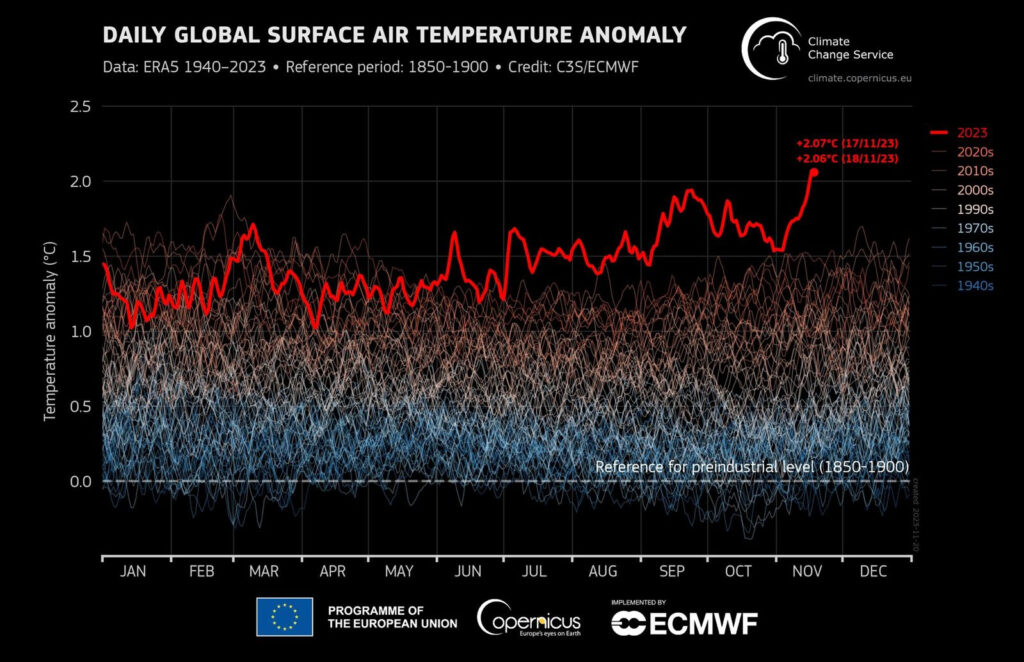The Two-Degree Future Is Now
In 2023, a number of climate records fell across a planet careening toward social and ecological chaos. Pedestrians pass the One World Trade Center, center, amidst a smokey haze from wildfires in Canada, Wednesday, June 7, 2023, in New York. (AP Photo/Julie Jacobson)
Pedestrians pass the One World Trade Center, center, amidst a smokey haze from wildfires in Canada, Wednesday, June 7, 2023, in New York. (AP Photo/Julie Jacobson)
On Nov. 17 and 18, the Earth’s global average surface temperature was recorded at more than two degrees Centigrade (3.6 degrees Fahrenheit) above pre-industrial levels for the first time. Anticipating this milestone, a team of ecologists and climate scientists in the journal BioScience warned in October, “We are now in an uncharted territory.” During the last 12 months, nearly every climate indicator reached record highs (and lows): the highest atmospheric concentrations of the three most potent greenhouse gases (carbon dioxide, methane and nitrous oxide) and the highest total CO2 emissions from the largest, most energy-consuming human population in history. According to Johan Rockstrom at the Potsdam Institute for Climate Impact Research, conditions on Earth may be “now well outside of the safe operating space for humanity.”
Some other 2023 records to consider at the turning of the year:
- Highest daily global temperature anomaly
- Hottest year and hottest months ever
- Highest sea surface temperatures
- Lowest Antarctic sea-ice extent
- Greatest gain in sea level rise
- Highest absorbed solar radiation
The United States experienced its warmest December, with almost the entire Lower 48 registering temperatures at least 3 F above normal (parts of Minnesota reached 15 F above normal for December). During winter, the Great Lakes typically reach 55% ice cover. As of this writing, they have a combined ice cover of 0.2% (Lake Superior has 0.5%, Lake Michigan 0%, Lake Huron 0%, Lake Erie 0%, Lake Ontario 0%).
The temperature anomaly in Canada was 5.88 C above the 1991-2020 historical “normal,” and some places, such as in Nunavut, reached 10 C above normal. According to data from the Copernicus Climate Change Service, Dec. 24 may have been the third hottest day — at 1.99 degrees Centigrade above pre-industrial — as compared to global average surface temperatures over the last 174 years.
In Africa, heat records during December fell in Nigeria (37 degrees Centigrade, or 98 degrees Fahrenheit, in Benin City), Republic of the Congo (35.5 degrees Centigrade in Makoua), Ghana (37.4 degrees Centigrade in Koforidua) and Cote D’Ivoire (36.6 degrees Centigrade in Daloa). In the first hours of 2024, records were being smashed across Oceania and Asia. The weather station in New Caledonia, at La Tontouta, recorded on Jan. 1 a temperature of 38.3 degrees Centigrade, its hottest day ever.

The Amazon may have reached a tipping point in 2023, transforming from a net carbon sink to a net carbon emitter as agriculture, mining and human settlement slashes the jungle into fragments, the basin dries out, and the ancient ecosystem dies. The ice shelves over the Amundsen Sea in west Antarctica are melting at accelerated rates, and the melting may be “locked in and beyond human control for the rest of this century, even if emissions are significantly reduced.”
In 2023 we witnessed the unfolding of what National Hurricane Center forecaster Eric Blake called “a nightmare scenario.”
According to the BioScience team, “Ocean acidity, glacier thickness and Greenland ice mass all fell to record lows…The increase in heat content and the rapid rise in sea surface temperatures are especially troubling, because they could have many serious impacts, including the loss of sea life, coral reefs dying because of bleaching and a rise in the intensity of large tropical storms.”
It was no surprise that in 2023 we witnessed the unfolding of what National Hurricane Center forecaster Eric Blake called “a nightmare scenario” with the sudden formation, over the superheated Pacific, of monstrous Hurricane Otis that smashed into Acapulco in October.
From a piece about Otis in The Philadelphia Inquirer:
Less than a day out, weather forecasters were describing Otis as a tropical storm that might bring heavy rain to Acapulco, but little more. But in the course of 12 hours over the overheated Pacific waters — in what some meteorologists are calling the most extreme example of “rapid intensification” they’ve ever seen — Otis gained an astonishing 115 mph in wind speed to become a major hurricane…“Something like this was bound to happen,” [said] Michael Mann, director of Philadelphia’s Penn Center for Science, Sustainability and the Media… [Mann] noted that the Pacific Ocean near Acapulco was unusually warm for this time of year, the result of both record temperatures linked to fossil-fuel pollution as well as the El Niño weather pattern. “It’s going to happen to Miami. It’s going to happen to Tampa,” Mann said.
Below is a short-list compilation, courtesy of the BioScience team, of some of the climate-related disasters that befell humanity in the raging heat of 2023 — the year that decades from now, trapped in a climate death spiral, we will look back to fondly as one of the coolest, sweetest, most clement in our lifetimes.
| Timeframe | Climate disaster |
| December 2022 to March 2023 | Heavy rainfall caused by atmospheric rivers led to multiple floods in the western United States. There were at least 22 fatalities and property damages were estimated to be $3.5 billion. Climate change may be increasing the likelihood of such catastrophic floods, although its effect on these particular storms is less clear. |
| February 2023 | Cyclone Gabrielle caused extreme rainfall in Aotearoa New Zealand’s Te Ika-a-Māui (North Island), potentially resulting in billions of dollars in damages and 225,000 homes losing power. This intense rainfall may be partly caused by a warming climate. |
| March–May 2023 | Record-breaking temperatures were recorded in parts of Southeast Asia, China and South Asia. The extreme heat caused deaths and school closures in India and led to more than 100 students requiring treatment for dehydration in the Philippines. It was likely at least partly because of climate change. For example, climate change has increased the likelihood of such an event to occur over Bangladesh and India by a factor of at least 30. |
| January–July 2023 | Intense wildfires in Canada burned roughly 10 million hectares, displacing 30,000 people at their peak, and worsening air quality across large portions of Canada and the United States. These extreme wildfires may be partly because of climate change, although many other factors are likely involved. |
| May 2023 | Tropical cyclone Mocha is reported to have killed at least 145 people in Myanmar and affected roughly 800,000 people in the region. Climate change may have made such storms more intense. |
| May–June 2023 | Tropical storm Mawar caused flooding and loss of power in parts of Guam. Mawar is the strongest cyclone ever recorded in the northern hemisphere in May. Climate change may be causing an increase in the intensity of tropical cyclones (Wu et al. 2022). |
| June 2023 | Deadly heat led to more than a dozen deaths in the Southern and Midwestern United States. Climate change is leading to an increase in the frequency and duration of such heat waves. |
| July 2023 | Up to six people died in Southwest Japan because of extremely heavy rainfall that caused floods and landslides. Climate change is likely making such heavy rainfall events more severe. Days later, floods and landslides, which may have been partly related to climate change, killed more than 26 people and led to thousands being evacuated in South Korea |
| July 2023 | Heavy monsoon rain caused flash floods and landslides in northern India that killed more than 100 people. Climate change is likely making monsoons in this region more variable, causing frequent landslides and floods. Heavy monsoon rains also damaged rice crops in India, raising concerns about global food prices and food security and prompting an export ban on non-basmati varieties. |
| June–August 2023 | Extreme heat in the United States killed at least 147 people. In the absence of climate change, the extreme heat seen in July 2023 in the United States would have been extremely unlikely to occur. |
| July–August 2023 | Beijing, China experienced its heaviest rainfall in at least 140 years, resulting in major flooding that affected nearly 1.29 million people, damaged 147,000 homes and caused at least 33 deaths. Intense flooding is likely becoming more common because of climate change. |
| August 2023 | In Hawaii, United States, catastrophic wildfires on the island of Maui killed at least 111 people, with more than 1,000 people likely missing, as of Aug. 18, 2023. Climate change may have decreased rainfall and increased temperatures in this region, potentially contributing to these fires. |
| September 2023 | Storm Daniel caused extreme flooding in Libya and parts of southeastern Europe, resulting in thousands of fatalities and more than $ 2 billion U.S. in damages. Climate change may be increasing the intensity of such storms. |
With an uncertain future and a new administration casting doubt on press freedoms, the danger is clear: The truth is at risk.
Now is the time to give. Your tax-deductible support allows us to dig deeper, delivering fearless investigative reporting and analysis that exposes what’s really happening — without compromise.
Stand with our courageous journalists. Donate today to protect a free press, uphold democracy and unearth untold stories.






You need to be a supporter to comment.
There are currently no responses to this article.
Be the first to respond.